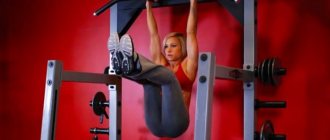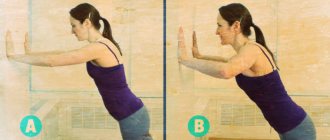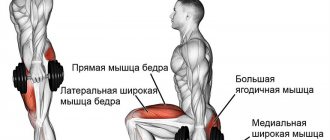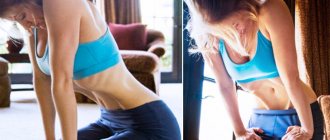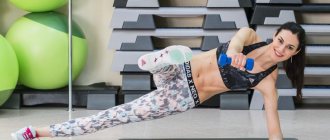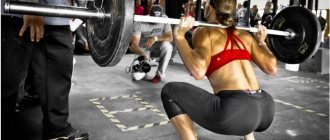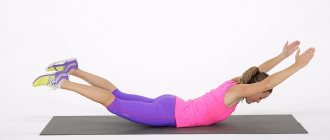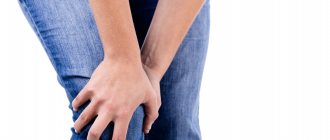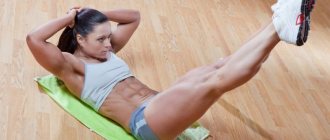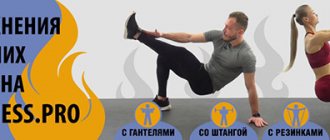Author: Timko Ilya - the ruler of the entire site and fitness trainer | more details >> Rod. 1984 Trained since 1999 Trained since 2007. Author and creator of the site tvoytrener.com. CCM in powerlifting. Champion of Russia and South Russia according to AWPC. Champion of the Krasnodar region according to IPF. 1st category in weightlifting. 2-time winner of the Krasnodar Territory championship in t/a. Author of more than 700 articles on fitness and amateur athletics. Author and co-author of 5 books.
Place in the ranking of authors:
out of competition
(become an author)
Date:
2012-05-29
Views:
510 403
Rating:
4.9
| All articles by the author >> | Medals articles >> |
Articles are loading...
| Article medals: | more than 500 thousand views |
Why medals are given to articles:
| Bronze medal: | |
| 1. The article is in the TOP 100 2. The article has more than 3. The article has more than 100 | |
| Silver medal: | |
| 1. The article is in the TOP 50 2. The article has more than 3. The article has more than 500 | |
| Gold medal: | |
| 1. The article is in the TOP 10 2. The article has more than 1 3. The article has more than 1,000 | |
Primary muscles - iliopsoas Additional - rectus abdominis Difficulty - medium
Correct technique
- For the fold exercise you will need a stable bench. You need to sit on it and then slightly raise your legs. They should always be suspended in front of the athlete. Legs bend slightly at the knees.
- You should tilt your body 45 degrees back relative to the bench. At the same time, your hands lie on the bench behind your back. This completes the formation of the starting position.
- After exhaling, the athlete pulls his knees to his chest, bending his legs at the joints, and then raising his body towards them.
- There is a short pause, after which the athlete can again move to the starting position.
Like this:
To work out your abdominal muscles as well as possible, you need to lean back as far as possible. This action will increase the amplitude of the exercise, which will have a positive effect on the results.
Leg raises can be performed without a bench, on the floor. However, it is important to always keep your feet elevated so that they do not touch the floor. After gaining enough experience, you can try holding a dumbbell between your legs. The extra weight will make the fold more difficult.
Beginners are recommended to perform 15-20 repetitions in 3 sets. For starters, this is quite enough. After a month or immediately after you feel stronger, you can do 4 sets of 20 repetitions.
Tips and tricks
Below we give some tips and recommendations on the technique of performing hanging lower limb lifts, which will help to avoid gross mistakes and wasted efforts for beginners and to perform the exercise efficiently for those whose sports training is at an average and higher level.
Basic mistakes of newbies
Beginners tend to make the following mistakes that should be avoided:
- strong swaying of the body and lifting of the lower limbs by inertia - when done this way, the exercise will bring absolutely no benefit;
- relaxation of the muscles of the shoulder girdle;
- helping with hands;
- improper breathing.
To avoid swinging, you need to learn to lower your legs smoothly and pause when they reach the lowest point.
About the features of the exercise and common mistakes:
https://youtu.be/7aYdQEd9qwQ
Execution Features
- When performing the exercise, you can use straps to secure your hands on the bar and elbow clamps. They will help you focus only on your abdominal muscles.
- The hands are not used during execution; they are relaxed and are used only for gripping.
- For maximum load on the oblique abdominal muscles, it is necessary to twist the body left and right - this is done with bent knees, which turn in different directions, rising each time.
- When lifting your legs, you need to tuck your pelvis - this will allow you to maximally tense your abdominal muscles.
- Inertia is unacceptable when performing this exercise. The ankle should rise and fall at each segment of the amplitude in the same amount of time.
- The lowering of the lower limbs should not be carried out completely - they should stop at the level of 15-25°. This way the abdominal muscles will remain tense throughout the entire exercise.
- It is not recommended to attach additional weights to your shins. The legs are a normal load to achieve the desired result.
- The chest must be kept open.
- If you feel pain in the lower back, you need to spread your toes and knees, while leaving your heels closed to each other. This should be more comfortable.
- If you cannot stabilize your body, you can ask a partner or instructor to hold you from behind.
- You need to look straight ahead. The chin resting on the chest is undesirable.
- At the end point of lifting your legs and after fixing them for two seconds, you need to additionally tense your abs.
- For beginners, it will be easier to do lifts of the lower extremities in a vertical position on the Swedish wall or parallel bars with a vertical back.
- The smaller the angle between the body and the hips, the greater the load on the abs.
Raising your legs only parallel to the floor does not give any results to the abdominal muscles. It should be above an angle of 90°. - A reverse grip on the bar is not recommended.
- The main attention should be paid not to raising the lower limbs, but to lowering them.
Safety
Some athletes complain that after performing the “fold” their tailbone rubs or hurts. To prevent the exercise from further injuring the delicate skin, it is recommended to place a towel or train on soft mats. This will increase comfort and help focus on the muscles.
An athlete performing a seated leg raise should always have their knees bent. This is done not only to maintain balance, but also to ensure safety for the knee joints.
It is important to keep your back in the same position throughout the exercise. If it deviates more, the lower back will be more involved in the work, rather than the abs. To prevent this from happening, you can slightly round the spine in the upper section.
Types and techniques of exercises
Next, we will talk about all types of leg lifts to the bar and the correct techniques for performing the exercises:
Raising straight legs while hanging on the bar
The most common and, perhaps, the most effective variation of this exercise. The technique is as follows:
- The athlete hangs from the bar at a level slightly wider than shoulder-width apart, keeping his arms and legs straight. We maintain natural lordosis in the spine, the gaze is directed forward. Let's take a deep breath.
- We exhale sharply and begin to pull our legs up, making a slight movement of the pelvis forward. We try to keep our legs straight and keep them in the same position throughout the entire approach. You can press your feet together or simply keep them at a short distance - whatever is more convenient for you.
© undrey — stock.adobe.com
- We raise our legs to a level just above the waist, trying to catch the maximum contraction of the rectus abdominis muscle. You can pause for a second at the point of peak contraction in order to additionally statically tense the muscle group we need. Smoothly begin to lower your legs down, inhaling.
© undrey — stock.adobe.com
Raising legs bent at the knees while hanging
This option is more suitable for beginner athletes who are not yet comfortable raising straight legs while hanging.
Its fundamental difference is that by working at the same amplitude with a shorter lever, we perform less force and can perform more repetitions. At the same time, it is important not to lose the neuromuscular connection; many beginners try to touch their knees almost to the chin, and this is fundamentally wrong. The movement must be done to the level at which the load on our muscles will be maximum; going higher does not make sense.
Alternate hanging leg raises
An interesting option for those who want to add something new to their training process. It differs significantly from previous types of leg lifts in that in it we combine static and dynamic loads: lifting one leg up to a right angle, part of our press performs dynamic work, while the other part of the press performs static work, being responsible for the stable position of the body , otherwise the athlete will turn slightly to the side.
In this position, it is important to monitor the position of the lower back; you do not need to bring the sacral area forward too much, since the spine will “twist” a little when lifting one leg.
Raising toes to the bar
This exercise differs from ordinary leg raises in that here we work in the longest amplitude and load the entire array of abdominal muscles.
When trying to touch your toes to the horizontal bar, try to minimize inertia and not raise your pelvis too high - this way you will create an unwanted load on the lumbar region and will involve the extensors of the spine and buttocks in the work. Our task is to work the abdominals as isolated as possible, while keeping the body motionless.
© milanmarkovic78 — stock.adobe.com
“Angle” (static holding of a right angle)
It's no secret that the combination of static and dynamic load is the key to constant progress. By performing the corner exercise, you force your abdominal muscles to work in a completely different mode, contracting them in an isometric manner.
© undrey — stock.adobe.com
Our task here is to raise your straight legs to a level parallel to the floor and stay in this position for as long as possible, keeping your legs motionless. At the same time, it is important not to forget about breathing, it should be smooth, without delay.
Many athletes who have well-developed quadriceps often complain that, along with the abs, part of the work is done by the front surface of the thigh. To “turn off” the quadriceps from work, you need to bend your knees slightly (about 10-15 degrees). The biomechanics of the movement may change slightly, so try raising your legs a little higher to feel the peak contraction of the abdominal muscles.
Common mistakes
Beginners love to “hack” when doing this exercise. To make it easier, they try to touch the floor and push off from it. There is no need to do this, because the exercise becomes simpler and less effective.
No need to make unnecessary movements on the bench . Any deviation or assistance with your hands can reduce the effectiveness of the exercise. If you can’t pump up your abs this way, then it’s better to notice the “fold” in straight crunches. It is recommended to exercise until the abdominal muscles become stronger.
Leg raises on a bench are never done using jerks . When jerking, the athlete overextends the muscles, which can cause injury.
Useful tips
- In the “fold,” the athlete’s body and his knees should always move towards each other. In other words, you need to simultaneously twist your body and bend your legs. It is for this reason that the exercise received such an unusual name.
- It is recommended to straighten your legs completely and tilt your torso as far back as possible. Ideally, the body and legs should form a straight line. Of course, this is difficult to achieve, but if you constantly try, the muscles will quickly acquire the necessary relief.
- There is no need to “drop” your feet on the floor. If the exercise is too difficult, then lightly touching the floor surface is allowed.
- At home, the “fold” is often done on the floor. However, it is important to know that in this case the legs will not fall below the horizontal, so the abs will stretch worse.
- Raising legs while sitting on a bench is not a basic exercise aimed at working the abs, since the range of motion is seriously limited. But this exercise is recommended for home performance due to the lack of special equipment and exercise equipment.
Proper nutrition for athletes should be selected especially carefully.
If you want to know which is the best elliptical trainer, then click here!
